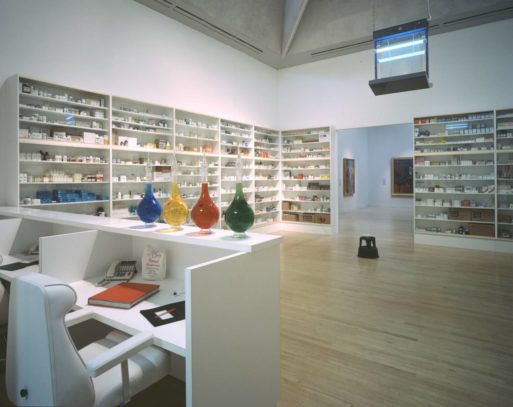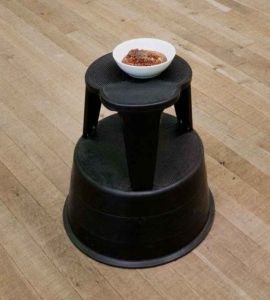Damien Hirst has always been a provocateur of sorts, and is one of contemporary art’s more controversial and well-respected figures. Much of his work explores death and the fragility of life, and his 1992 room-sized installation “Pharmacy” falls neatly into his personal canon.

Credit: tate.org.uk
While installed, “Pharmacy” at first glance appeared to be just that: a behind-the-scenes look into a pharmacist’s world. The public is allowed into a place it rarely has access to, and the room appears to be a sort of temple to the “art” of medicine.
Thousands of pill bottles and medicinal boxes rest on wooden shelves along the room’s edges. They are strategically placed, providing a sense of order. Many of the receptacles are very colorful and contribute a pleasing aesthetic appeal to the open space.
Numerous shelves have sliding glass doors. Perhaps the artist did this intentionally as a way to entice viewers to reach for the medicine. Medicine here, for Hirst, represents a short-term cure, a concept that could be viewed as the ultimate purpose of the installation.
Drugs and medication can only prolong the inevitability of death and are rife with potential side-effects, which only bring more pain and discomfort. Medicine offers just an abbreviated respite from the certainty of death.
“Pharmacy” requires viewers to really think about where they are, and why it is set up the way it is. We’re supposed to contemplate the importance of medicine in our lives and why we take prescribed pharmaceuticals. Perhaps Hirst would like us to think about alternative medicines or why we are so trusting of pharmaceutical companies.

Credit: tate.org.uk
A few important pieces to the “Pharmacy” puzzle are four footstools. They are strategically placed in the middle of the room, appearing as four corners of a square. Bowls of honeycomb lay on them, complementing the idea that medicine can’t prevent death. An insect-o-cutor hangs above the middle of the “square” from the ceiling.
The honeycomb here serves as the leading, operational metaphor: It will attract flies and other bugs, but will ultimately lure them to their quick deaths. Medicine attracts us because it relieves our pain. Though drugs may provide relief, many of them ultimately do not cure the affliction and only serve as a short-lived respite.
I do not think that Hirst here is trying to say that medicine is worthless. It may be that he just wants us to mull over the idea that medicine only serves to postpone the inevitable. People are taught to believe in the power of medicine, regardless of the possible side-effects.
The Artist’s Take
Hirst has a few thoughts on the meaning behind the work:
We all die, so this kind of big happy, smiling, minimal, colourful, confident facade that medicine and drug companies put up is not flawless — your body lets you down, but people want to believe in some kind of immortality.

Credit: damienhirst.com
For many people a pharmacy and its products offer hope. It is a place that embodies an ideal of health and well-being. When most people consider medicine and pharmaceuticals, their fears of pain and death seem to go away. But this is only for a short time.
Hirst said, “I can’t understand why some people believe completely in medicine and not in art, without questioning either.” He finds it strange that people are so willing to place their trust in medicine, but don’t have a similar faith in the therapeutic nature of art.
Though the overall message may be a bit morose, I think “Pharmacy” serves its purpose. It asks us to contemplate life and death, and to perhaps question our sometimes blind faith in medicine and pharmaceutical companies.

 “Pharmacy” Asks Us To Consider Medicine and The Fragility of Life
“Pharmacy” Asks Us To Consider Medicine and The Fragility of Life



 Funeral Favors Offer Visitors a Tangible Memento
Funeral Favors Offer Visitors a Tangible Memento
 “Comeback” by Prince
“Comeback” by Prince















